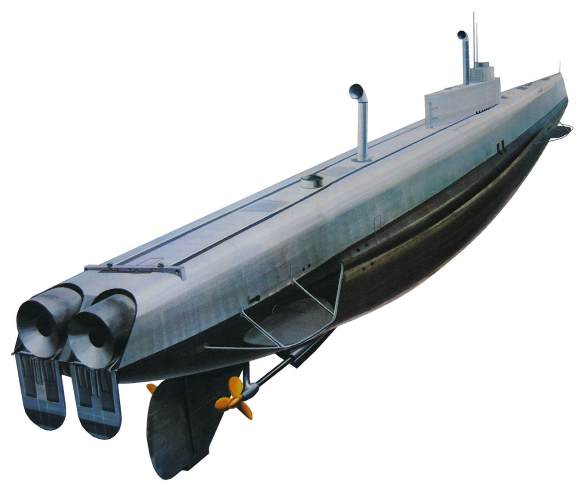World’s first submarine minelayer (Krab)
In 1914 the Russians were probably the greatest proponents of mine warfare. Much of their fleet had been destroyed in the Russo-Japanese War and the replacements were not yet in service in great numbers. Even then the Russian Baltic fleet could hardly match the German High Seas Fleet. In November 1906, therefore, the Russians began to plan large mine barrages to deny the Germans access to the Gulf of Bothnia and to their capital, St Petersburg.33 By 1914 the Russians had already laid down the world’s first submarine minelayer (Krab), which would be completed in 1915, after the first German minelaying U-boats. The Baltic Fleet strategy approved by the Tsar in 1912 envisaged offensive minelaying off the German coast plus a defence, involving heavy minefields, of the Central Position defending the capital. In 1914 the Russians had 7000 mines in the Baltic, 4500 in the Black Sea and 4000 at Vladivostok (1000 of which were later given to the Royal Navy). The first field of 2129 mines was laid in a single day in July 1914 to protect the Central Position; later minesweepers and torpedo boats added 871 and 290 mines, respectively, to guard the flanks of the main minefield. After a German feint attack on Windau, destroyers laid 100 mines to protect that port. Later in 1914 the Russians began to lay mines off German ports to immobilise the German fleet in the Baltic, beginning with 295 mines laid in three barriers off Memel.
The Baltic Fleet laid 3648 mines in offensive barriers and 34,943 mines in defensive barriers, the latter beginning with the 2995 mines laid to protect the Central Position in 1914 (plus another 2165 in 1916 and another 4342 between May and September 1917). The Black Sea Fleet laid a total of 6385 mines in defensive fields (1750 mines off Sevastopol, 3513 off Odessa, 550 in the Kerch Straits and 572 off Batumi/Poti). Offensive mining amounted to 5238 mines in the Bosporus, 440 off Anatolia (to disrupt Turkish sea traffic supporting army operations) and 1370 off Varna/Constanta.
In the Baltic, mines sank the armoured cruiser Friedrich Carl on 17 November 1914 and the light cruiser Bremen on 17 December 1915. The light cruiser Augsburg was mined (but not sunk) on a Russian barrier on 24/25 January 1915 and the old cruiser Gazelle was so badly damaged that she was towed home but not repaired. During the German attack on the Åland islands in 1917 (12 October 1917), the battleship Bayern was seriously damaged but not sunk by a mine. Seven of eleven German destroyers were mined and sunk during a night raid in the Baltic on 10 November 1916 (S 57, S 58, S 59, V 72, V 75, V 76 and G 90). Other modern German destroyers mined in the Baltic were S 31 (19 August 1915), V 99 (17 August 1915), V 162 (13 August 1916) and S 64 (18 October 1917). In addition, during the British intervention in Russia, the cruiser Cassandra (5 December 1918) and the destroyer Verulam (4 September 1919) were mined. There were also lesser craft. In addition, mines seem to have claimed three U-boats (U 26 about 31 August 1915, U 10 about 26 May 1916 and UC 57 about 18 November 1917). In the Black Sea, the Turkish cruiser Medjidieh was sunk off Odessa (3 April 1915). Mines also sank the gunboat Berk (2 January 1915); the smaller gunboats Duruk Reis, Hizir Reis and Issa Reis (all in 1915); and the submarines UB 45, UC 15 and UB 46 (1916), plus lesser craft.
